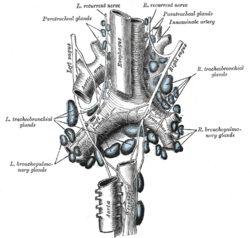Tracheobronchial lymph nodes
| Tracheobronchial lymph nodes | |
|---|---|
 The tracheobronchial lymph glands. | |
 1. Pulmonary Juxtaesophageal 2. Bronchopulmonary (Hilar) 3. Superior Tracheobronchial 4. Inferior Tracheobronchial 5. Paratracheal | |
| Details | |
| System | Lymphatic system |
| Drains to | Bronchomediastinal trunk |
| Identifiers | |
| Latin | Nodi lymphoidei tracheobronchiales |
| Anatomical terminology | |
The tracheobronchial lymph nodes form four main groups:
- (a) tracheal, on either side of the trachea;
- (b) bronchial, in the angles between the lower part of the trachea and bronchi and in the angle between the two bronchi;
- (c) bronchopulmonary, in the hilum of each lung; and
- (d) pulmonary, in the lung substance, on the larger branches of the bronchi.
The afferents of the tracheobronchial glands drain the lungs and bronchi, the thoracic part of the trachea and the heart; some of the efferents of the posterior mediastinal glands also end in this group.
Their efferent vessels ascend upon the trachea and unite with efferents of the internal mammary and anterior mediastinal glands to form the right and left bronchomediastinal trunks.
References
This article incorporates text in the public domain from page 717 of the 20th edition of Gray's Anatomy (1918)
External links
- Anatomy photo:21:09-0103 at the SUNY Downstate Medical Center - "Mediastinum: Tracheobronchial Lymph Nodes and the Carina"
- http://www.instantanatomy.net/thorax/vessels/lnodes.html
This article is issued from
Wikipedia.
The text is licensed under Creative Commons - Attribution - Sharealike.
Additional terms may apply for the media files.